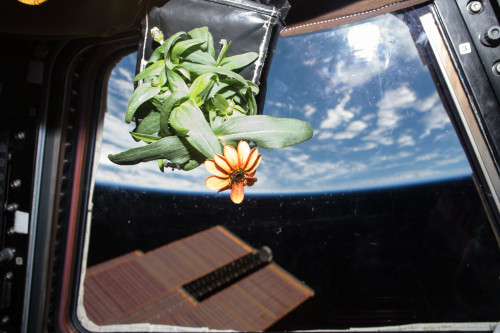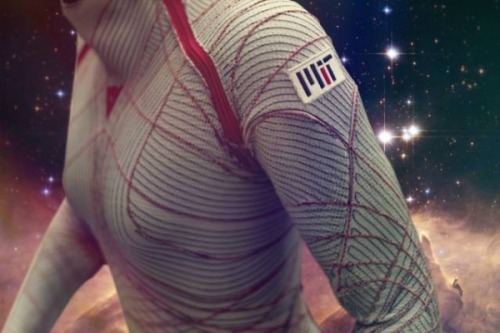Take A Moment, Look Outside Your Window. 🌷🌼



Take a moment, look outside your window. 🌷🌼
Today is the #FirstDayOfSpring in the Northern Hemisphere, also known as the vernal equinox.
#DYK Earth’s tilted axis causes the season? Throughout the year, different parts of Earth receive the Sun’s most direct rays. So, when the North Pole tilts toward the Sun, it’s summer in the Northern Hemisphere. And when the South Pole tilts toward the Sun, it’s winter in the Northern Hemisphere.
These images are of Zinnias. They are part of the flowering crop experiment that began aboard the International Space Station on Nov. 16, 2015, when NASA astronaut Kjell Lindgren activated the Veggie system and its rooting “pillows” containing zinnia seeds.
Make sure to follow us on Tumblr for your regular dose of space: http://nasa.tumblr.com.
More Posts from Fillthevoid-with-space and Others

After over a century of observations and several theories, scientists may have finally nailed the origin of the high-speed plasma blasting through the Sun’s atmosphere several times a day. Using a state-of-the-art computer simulation, researchers have developed a detailed model of these plasma jets, called spicules.
The new findings answer some of the bigger questions in solar physics, including how these plasma jets form and why the Sun’s outer atmosphere is far hotter than the surface.
“This is the first model that has been able to reproduce all the features observed in spicules,” Juan Martinez-Sykora, lead author and astrophysicist at the Bay Area Environmental Research Institute in California, told ScienceAlert.
Continue Reading.

Light Echoes Used to Study Protoplanetary Disks : This illustration shows a star surrounded by a protoplanetary disk. A new study uses data from NASAs Spitzer Space Telescope and four ground-based telescopes to determine the distance from a star to the inner rim of its surrounding protoplanetary disk. Researchers used a method called photo-reverberation, also known as light echoes.
js

Next Generation Spacesuit like Second Skin
Scientists from MIT have designed a next-generation spacesuit that acts practically as a second skin, and could revolutionize the way future astronauts travel into space. (Photo : Jose-Luis Olivares/MIT)
Astronauts are used to climbing into conventional bulky, gas-pressurized spacesuits, but this new design could allow them to travel in style. Soon they may don a lightweight, skintight and stretchy garment lined with tiny, muscle-like coils. Essentially the new suit acts like a giant piece of shrink-wrap, in which the coils contract and tighten when plugged into a power supply, thereby creating a “second skin.”
“With conventional spacesuits, you’re essentially in a balloon of gas that’s providing you with the necessary one-third of an atmosphere [of pressure,] to keep you alive in the vacuum of space,” lead researcher Dava Newman, a professor of aeronautics and astronautics and engineering systems at MIT, said in astatement.
“We want to achieve that same pressurization, but through mechanical counterpressure - applying the pressure directly to the skin, thus avoiding the gas pressure altogether. We combine passive elastics with active materials. … Ultimately, the big advantage is mobility, and a very lightweight suit for planetary exploration.”
Newman, who has worked for the past decade on a design for the next-generation spacesuit, describes the new garment in detail in the journal IEEE/ASME: Transactions on Mechatronics.
The MIT BioSuit’s coils, which are a main feature of the outfit, are made from a shape-memory alloy (SMA). At a certain temperature, the material can “remember” and spring back to its engineered shape after being bent or misshapen.
Skintight suits are not a novel idea, but in the past scientists have always struggled with the question: how do you get in and out of a suit that is so tight? That’s where the SMAs come in, allowing the suit to contract only when heated, and subsequently stretched back to a looser shape when cooled.
Though the lightweight suit may not seem at first like it can withstand the harsh environment that is outer space, Newman and his colleagues are sure that the BioSuit would not only give astronauts much more freedom during planetary exploration, but it would also fully support these space explorers.
Newman and his team are not only working on how to keep the suit tight for long periods of time, but also believe their design could be applied to other attires, such as athletic wear or military uniforms.
“An integrated suit is exciting to think about to enhance human performance,” Newman added. “We’re trying to keep our astronauts alive, safe, and mobile, but these designs are not just for use in space.”
why is there star
gas cloud get squished (gravitational collapse) then sometimes smaller elements can squish together to make bigger elements (nuclear fusion) and this continues as long as the smolest elements (hydrogen and helium) are in the core

This Black Eye Galaxy that got its name from the band of light absorbing dust appearing in front of the star systems bright center in the Hubble space telescope.
via reddit

I’m a Northern Hemisphere dweller, so I thought it would be fun to cover Southern Hemisphere stars and constellations in this episode! I also coulsnt’ resist talking about Aurora Australis and Steve, the hot new atmospheric phenomenon all the young people are talking about.
Below the cut, I have the glossary, transcript, sources, and music credits. I take topic suggestions from Tumblr messages, or you can tweet at me on Twitter at @HDandtheVoid, or you can ask me to my face if you know me. Please subscribe on iTunes, rate my podcast and maybe review it, and tell friends if you think they’d like to hear it!
(My thoughts on the next episode are Chuck Yeager, Stephen Hawking and his theories, the opposition of Mars, or famous comets. The next episode will go up May 14th or 21st!)
Glossary
Bayer designation - a way to classify stars based on their relative brightness within a constellation. A specific star is identified by a Greek letter, followed by the genitive form of the constellation's Latin name.
circumpolar - appearing to orbit one of the Earth’s poles. For stars and constellations, this means they are above the horizon at all times in certain latitudes.
irregular galaxy - an asymmetrical galaxy shape, where the galaxy lacks a central supermassive black hole.
Script/Transcript
Sources
Orion from the Southern Hemisphere via EarthSky (Mar 2017)
How to Spot Sky Landmarks: Big Dipper and Southern Cross via Space.com (Apr 2012)
Locate Cassiopeia the Queen via EarthSky (February 2018)
Small Magellanic Cloud orbits Milky Way via EarthSky (Oct 2017)
Nubecula via LatDict
Early star catalogues of the southern sky via Astronomy and Astrophysics (2011)
Catalog of Southern Stars via the University of Oklahoma
Edmond Halley via Royal Museums Greenwich
Finding south using the Southern Cross via Museum of Applied Arts and Sciences (Jan 2013)
List of 88 official constellations via the Astronomical Society of Southern Africa
Alpha Centauri system, closest to sun via EarthSky (May 2017)
Hadar is a southern pointer star via EarthSky (April 2017)
Aurora Australis forecast service
Video of aurora australis via Global News Canada (April 2018)
Aurora Steve via Global News Canada (March 2018)
Bagnall, Philip M. “Crux.” In The Star Atlas Companion: What You Need to Know About the Constellations. Springer Science+Business Media: New York, 2012 (183-7). Located in Google Books Preview [accessed May 1, 2018].
Intro Music: ‘Better Times Will Come’ by No Luck Club off their album Prosperity
Filler Music: ‘Mace Spray’ by The Jezabels off their EP Dark Storm.
Outro Music: ‘Fields of Russia’ by Mutefish off their album On Draught
Asteroid to Fly Safely Past Earth on April 19
Asteroid Watch logo. April 7, 2017
Artist’s impression of a Near-Earth Asteroid passing by Earth. Image Credit: ESA
A relatively large near-Earth asteroid discovered nearly three years ago will fly safely past Earth on April 19 at a distance of about 1.1 million miles (1.8 million kilometers), or about 4.6 times the distance from Earth to the moon. Although there is no possibility for the asteroid to collide with our planet, this will be a very close approach for an asteroid of this size. The asteroid, known as 2014 JO25, was discovered in May 2014 by astronomers at the Catalina Sky Survey near Tucson, Arizona – a project of NASA’s NEO Observations Program in collaboration with the University of Arizona. (An NEO is a near-Earth object). Contemporary measurements by NASA’s NEOWISE mission indicate that the asteroid is roughly 2,000 feet (650 meters) in size, and that its surface is about twice as reflective as that of the moon. At this time very little else is known about the object’s physical properties, even though its trajectory is well known. The asteroid will approach Earth from the direction of the sun and will become visible in the night sky after April 19. It is predicted to brighten to about magnitude 11, when it could be visible in small optical telescopes for one or two nights before it fades as the distance from Earth rapidly increases.
Asteroid 2014 JO25
Video above: This computer-generated image depicts the flyby of asteroid 2014 JO25. The asteroid will safely fly past Earth on April 19 at a distance of about 1.1 million miles (1.8 million kilometers), or about 4.6 times the distance between Earth and the moon. Video Credits: NASA/JPL-Caltech. Small asteroids pass within this distance of Earth several times each week, but this upcoming close approach is the closest by any known asteroid of this size, or larger, since asteroid Toutatis, a 3.1-mile (five-kilometer) asteroid, which approached within about four lunar distances in September 2004. The next known encounter of an asteroid of comparable size will occur in 2027 when the half-mile-wide (800-meter-wide) asteroid 1999 AN10 will fly by at one lunar distance, about 236,000 miles (380,000 kilometers). The April 19 encounter provides an outstanding opportunity to study this asteroid, and astronomers plan to observe it with telescopes around the world to learn as much about it as possible. Radar observations are planned at NASA’s Goldstone Solar System Radar in California and the National Science Foundation’s Arecibo Observatory in Puerto Rico, and the resulting radar images could reveal surface details as small as a few meters. The encounter on April 19 is the closest this asteroid has come to Earth for at least the last 400 years and will be its closest approach for at least the next 500 years. Also on April 19, the comet PanSTARRS (C/2015 ER61) will make its closest approach to Earth, at a very safe distance of 109 million miles (175 million kilometers). A faint fuzzball in the sky when it was discovered in 2015 by the Pan-STARRS NEO survey team using a telescope on the summit of Haleakala, Hawaii, the comet has brightened considerably due to a recent outburst and is now visible in the dawn sky with binoculars or a small telescope. JPL manages and operates NASA’s Deep Space Network, including the Goldstone Solar System Radar, and hosts the Center for Near-Earth Object Studies for NASA’s Near-Earth Object Observations Program, an element of the Planetary Defense Coordination Office within the agency’s Science Mission Directorate. More information about asteroids and near-Earth objects can be found at: http://cneos.jpl.nasa.gov http://www.jpl.nasa.gov/asteroidwatch For more information about NASA’s Planetary Defense Coordination Office, visit: http://www.nasa.gov/planetarydefense For asteroid and comet news and updates, follow AsteroidWatch on Twitter: https://twitter.com/AsteroidWatch Image (mentioned), Video, Text, Credits: NASA/Tony Greicius/JPL/DC Agle. Greetings, Orbiter.ch Full article
This has been going on since 1995! There are so many pictures! I gotta check these out but it will take hours. Maybe treat myself to like ten a day? It’s a better way to wake up than checking Facebook right now, I like this plan.
-
 lunamazes reblogged this · 11 months ago
lunamazes reblogged this · 11 months ago -
 lunamazes liked this · 11 months ago
lunamazes liked this · 11 months ago -
 learnheadvassbidcooks liked this · 1 year ago
learnheadvassbidcooks liked this · 1 year ago -
 itsjustalittlevampire reblogged this · 2 years ago
itsjustalittlevampire reblogged this · 2 years ago -
 stardating reblogged this · 3 years ago
stardating reblogged this · 3 years ago -
 maryjaneyoudrivemeinsane reblogged this · 3 years ago
maryjaneyoudrivemeinsane reblogged this · 3 years ago -
 chilled-manu liked this · 3 years ago
chilled-manu liked this · 3 years ago -
 fayelafaye liked this · 4 years ago
fayelafaye liked this · 4 years ago -
 fastofthekillones liked this · 4 years ago
fastofthekillones liked this · 4 years ago -
 annoyinglyeclecticruins reblogged this · 4 years ago
annoyinglyeclecticruins reblogged this · 4 years ago -
 annoyinglyeclecticruins liked this · 4 years ago
annoyinglyeclecticruins liked this · 4 years ago -
 lbittersweet liked this · 4 years ago
lbittersweet liked this · 4 years ago -
 promptgpt liked this · 4 years ago
promptgpt liked this · 4 years ago -
 withkneesafringed reblogged this · 4 years ago
withkneesafringed reblogged this · 4 years ago -
 dia0301 liked this · 4 years ago
dia0301 liked this · 4 years ago -
 autisticaceboy liked this · 4 years ago
autisticaceboy liked this · 4 years ago -
 diamondkeeling liked this · 4 years ago
diamondkeeling liked this · 4 years ago -
 bezkraen reblogged this · 4 years ago
bezkraen reblogged this · 4 years ago -
 corv1kn1ght liked this · 4 years ago
corv1kn1ght liked this · 4 years ago -
 reallywannafly liked this · 4 years ago
reallywannafly liked this · 4 years ago -
 grrrlgerms liked this · 4 years ago
grrrlgerms liked this · 4 years ago -
 flippingmyfins liked this · 4 years ago
flippingmyfins liked this · 4 years ago -
 lamaplant liked this · 4 years ago
lamaplant liked this · 4 years ago -
 vosquitransitis liked this · 4 years ago
vosquitransitis liked this · 4 years ago -
 babblefishgirl liked this · 4 years ago
babblefishgirl liked this · 4 years ago -
 renjunniesmoomin liked this · 4 years ago
renjunniesmoomin liked this · 4 years ago -
 violetablood liked this · 4 years ago
violetablood liked this · 4 years ago
A podcast project to fill the space in my heart and my time that used to be filled with academic research. In 2018, that space gets filled with... MORE SPACE! Cheerfully researched, painstakingly edited, informal as hell, definitely worth everyone's time.
243 posts










